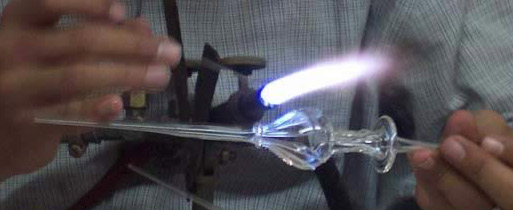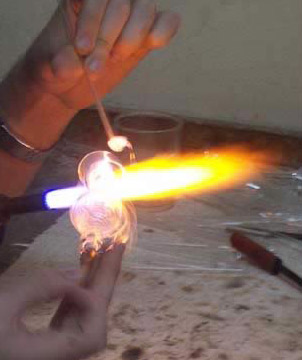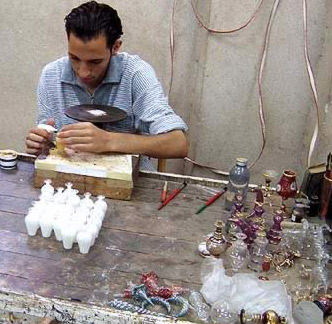Tricks of the Trade:
Purchasing Egyptian Glass Perfume Bottles
by Diaa Khalil

Notation: Not going to Egypt anytime soon? High quality hand made Egyptian perfume bottles are available in Tour Egypt's Virtual Khan el-Khalili.
One trip to Egypt is enough to know that one of the grandest treasure that remains are the people, and the hand made products they produce are the best you can find and see in Egypt. There are many varieties of hand made products, including such items as alabaster objects, painted papyrus, brass and glassware, among others. Nevertheless, there are some products people say are hand made but in fact, are not. However, glass perfume bottles are exclusively hand blown, becoming beautiful works of pure art.
From the earliest times, Egyptians have worked with glass, and even prior to their capacity to actually produce this substance, they used a limited amount of natural glass produced through volcanic action or meteorite impacts in various jewelry and decorative effects. The Egyptians probably did not invent man made glass, but they did adapt this technology early on for their own uses. Initially, it seems that the first examples of man-made glass from Mesopotamia and Egypt were beads dating from the 3rd millennium BC.
A formative era in the history of glass-making is marked by the appearance of the first glass vessels in the middle of the 2nd millennium BC, again in Mesopotamia and Egypt. These vessels were made by an ingenious method involving molding on a core. Since glass-blowing was unknown in this early period, a core was made in the shape of the desired vessel from a material strong enough to withstand heating and fireable enough to be removed from the finished article.

Viscous glass was applied to this core. The surface of the vessel was then decorated with threads of colored glass combed into ornamental patterns. The vessel was afterwards rolled on a flat surface and a handle and a base were added. This method required a high degree of skill. The colors of the glass used in this period indicate that the makers tried to imitate precious stones such as lapis-lazuli and turquoise. The making of glass vessels began almost at the same time in Egypt and in northern Mesopotamia but there are indications that the core technique was invented in Mesopotamia and introduced into Egypt later. The heyday of Egypts glass industry came in the Amarna period (first half of the 14th century BC).

Glass vessels were rare in Palestine and Syria in the Late Bronze Age. And only princes and the very rich could afford them. Some vessels were dedicated to temples and shrines. Others were found in tombs. All these vessels seem to have been imported from Egypt, except for a Mesopotamian conical beaker discovered at Megiddo.
Casting glass into molds was only of minor importance during the New Kingdom, but continued to at least a small extent after core-forming had been abandoned due to the introduction of glass blowing under the Romans. In the New Kingdom the Egyptians had all they needed to produce blown glassware: the raw materials in abundance, aerated furnaces reaching high temperatures and ceramic blow tubes. Still, glass blowing was not invented until the first century BC in Syria. Mass production of blown glass objects was not introduced until Roman times.

Blown glass vessels were created by sticking a piece of molten glass onto one end of a blowpipe and through the other end introducing pressurized air into the pipe. This was done by blowing.
Decorations were added by pinching the hot glass, adding handles or other features to it like strands of differently colored glass which could then be pinched to change simple straight patterns into more intricate ones.
The type of glass perfume bottles we see today in Egypt are, however, a more modern art, probably having been made since the beginning of the 19th century. That was when a resurgence in the art form of glass took place.The techniques are now handed down from generation to generation, usually from father to son, as the profession is mainly limited to men.

Today, these bottles are most numerous in the famous Khan el-Khalili market, where one may find every shape, size, color and ornamentation of such bottles. Of course, they are also available in almost every location one might find tourists in Egypt. However, most of the glass factories are located in Shobra el-Khema, though there are others right in the Khan el-Khalili and elsewhere. If one is visiting Egypt, it is not difficult to visit one of these factories, and in fact it is sometimes hard not to, as vendors will sometimes insistently beg one to do so.

In order to make these products, the factories first import fine Pyrex glass as tubes in different textures. Most of these tubs are imported from Czechoslovakia and Germany. After considering a design, which is sometimes laid out on paper, but also sometimes in the artist's head, the artist chooses the best textured tube for his design. Next he draws the design on the glass tube as a pattern so that the tub can be cut into pieces that fit his design. Then the magic beings.
The artist begins by firing the glass and shaping the various pieces of the perfume bottle. In some instances, several artists may in fact work on the same perfume bottle each blowing a different part of the design. The fire, which heats the glass to a very high temperature of 1000 C using pressurized oxygen, makes the glass very flexible. At this point, the glass is almost liquid.

Using a number of small tools, the glass is constantly rotated as the artist blows air through it quickly and precisely to achieve an exact shape. Afterwards, another craftsman, with very different handicraft skills, takes over the bottle in order to engrave the shaped glass with designs. Extra care is required in cutting into the strong but delicate glass.
Typically, a third craftsman may apply coloring to the perfume bottle. Most of the colors, with the exception of gold, are imported either from Germany or Turkey. Some very beautiful effects may be applied, while solid colored bottles will be turned on a rotating wheel to distribute the colors smoothly and evenly without leaving marks or uneven streaks of color. Bottles with scenes or floral decorations are painted by hand. On better bottles, gold will next be applied. This is 12 ct liquid gold, which requires care in its application. Some bottles have gold colored paint and so are less expensive, but also inferior to and less brilliant than their counterparts painted with real gold.

After the coloring and hand painting process is completed the bottles are put into an oven with a temperature near 500 and 650 C for about half an hour to bake or set the color on the glass so that it is permanent. Bigger bottles may take a few hours in the oven before the color is set. Only after this firing do all the decorative effects become visible. After the bottles are removed from the oven, they need to be left out to cool. This is the last step before they are sent to the stores to be presented for sale.
These beautiful bottles come in a variety shapes, colors, and sizes, from the very small to extra large.We may find perfume bottles in abstract designs, or in the shape of many physical objects such as a variety of animals. There is also, it seems, an infinite variety of stoppers from simple tear drop shapes to intricate fish and birds. However, other glass objects made in the same manner are also available, such as candlestick holders and oil burners.

What to Look for
There remains a few factories in Egypt that do not use Pyrex for their perfume bottles. These companies actually deal with the Cairo garbage people who bring them all kinds of discarded light bulbs (as well as probably some other glass objects). This material is then cleaned, and used to produce perfume bottles that are much more fragile than their Pyrex counterparts. Because the wall thickness of these bottles is thinner then those of better quality, tapping on them will produce a sharp, higher pitch than that of a Pyrex perfume bottle. Such bottles are usually much simpler and less decorated than Pyrex bottles as well.

Pyrex perfume bottles themselves may, at times, be badly formed and lean to one side or the other. These are obvious in shops, but if buying Egyptian perfume bottles on-line or by mail order, it is important to deal with a reputable company in order to avoid such flaws. Also, bottles painted with true gold are fairly easy to distinguish from those decorated with gold colored paint, for they will lack the brilliance of the former.
Always check the plunger within the stopper. These may not be very long, but they should not be broken off with sharp edges, a common problem found on even very fine perfume bottles after having been shipped. Also, be sure to carefully inspect the top of tear shaped stoppers, as the very upper edge can sometimes be damaged.
The best way to keep the bottle as safe as possible during shipping is to wrap it in a bubble wrap or cotton within a cardboard box. However, it should be noted that perfume bottles made of Pyrex are fairly strong.
References:
Original research by Diaa Khalili
last updated: June 8th, 2011

